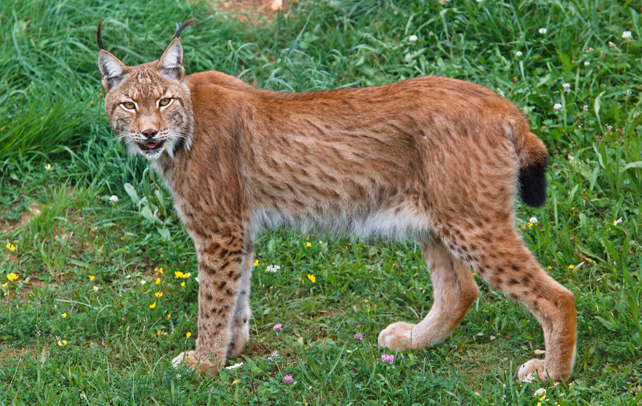Facts About Iberian Lynx

It looks Egyptian, with its tiny little beard and sphinx like aura. It hunts like a Greek, with stealth like killing foreplay; creeping through its den, waiting silently on a tree or a rock, and in a split second grab hold of the neck of its prey and burst it open. It is actually a Spaniard, found in Southern Europe in the Iberian Peninsula of Spain and Portugal. It is an Iberian Lynx, and it is said that only a few, around 200, of these remain now. They are the most endangered feline species of cats. Though ferocious, lynxes possess the common courtesy to bury the remains of the prey they feed on—an honour to the fallen warrior if you may say. Find out some more interesting and amazing facts on this wild creature.
Facts About Iberian Lynx
Binomial Name: Lynx Pardinus
Kingdom: Animalia
Phylum: Chordata
Subphylum: Vertebrata
Class: Mammalia
Order: Carnivora
Family: Felidae
Genus: Lynx
Species: L.pardinus
Length: 65 to 100 cm (body) 5 to 19 cm (tail)
Height: 60 to 70 cm (shoulder)
Length: 85 to 110 cm (head and body length)
Tail Length: 12 to 30 cm
Weight: 5 to 15 kg
Average Lifespan: 13 years
Diet: Carnivorous; rabbits, small birds, ducks, hares, rodents, partridge and even roe deer.
Range: South western Spain and Portugal
Habitat: Dense scrub for shelter and open pasture for hunting
Age of Sexual Maturity: Males – 1 year; Females – 1 year
Gestation Period: 60 days
Average Litter Size: Two to three
Interesting And Fun Facts About Iberian Lynx
- Earlier, Iberian lynxes were classified under Eurasian lynx but now have been considered a separate species with a cat like face, and have a distinct skin marking than their European cousins.
- They mostly catch small preys; rabbits and hares are their favourite food, consisting of 70 to 80 % of their diet. Though these carnivorous animal are also known to feed on birds, rodents and hares. It’s the ear tuffs that aid Iberian lynxes in locating their prey while their thick paws enable them to walk silently.
- An Iberian lynx has tufted ears, a short tail, and a ruff of fur beneath the chin that resembles a human beard. It also has distinctive leopard like spots with a covering of grey or light brownish yellow, plus shorter hair than the other species of lynx.
- The male Iberian lynxes are much larger than the female ones.
- Iberian lynx can survive in cold climate as its body is designed in such a way, and can settle in plains and cold mountains. The long hair on its feet helps it move silently across the snow and also regulate body temperature.
- Iberian lynxes are terrestrial animals and have a span of 10 square miles from their den, but can cover long distances when there is scarcity of food.
- The females are the ones that initiate mating, leaving their home range to find males. The kittens are born between March and April and one litter contains 2-3 kittens. A newborn weighs around 200 to 250 grams.
- The kittens stay in the den for a few months till they learn some survival skills. They become independent at the age of 10 months, but continue to stay with their mother until they are almost 2 years old.
- When the Iberian lynx attains a couple of months, they become very aggressive and sometimes kill each other. The aggressive behaviour lasts to about 30 days and then settles down.
- While a male requires one rabbit in a day, the female on the other hand, bringing up the kittens, requires three. They become stronger and thick as they reach around three years old.
- Iberian lynxes have amazing eyesight and can spot a mouse even from a distance of 250 feet.
- When a lynx kills, it consumes its prey, and after the cat is done eating; it buries the remains.
- Lynxes are nocturnal and are most active after sunset and before sunrise.
- They are very good in climbing trees. They use a variety of locations for breeding lairs.There are no subspecies of Iberian lynx.
- Iberian lynx, also known as Spanish lynx and Pardel lynx, is one of the rarest animals in the world. It is also listed as the most endangered of the cat species.
- There has been a massive decline in the number of Iberian lynx, mainly because of their main prey rabbit’s scarcity due to disease, poaching, accidents and hunting.
- Iberian lynxes once lived in Southern France and Iberian Peninsula. Today, around 200 Iberian lynxes are estimated to inhabit south western Spain and Portugal.
- Out of the few Iberian lynxes that are remaining, there are only 40 females remaining who are capable of breeding.
- They prefer open grasslands mixed with dense shrubs and trees.
- The lynxes puff when they are frightened or irritated.
- Captive breeding is been initiated in Spain to protect these endangered species.
- The Iberian lynx kill and displace other predator that eats rabbits including foxes. They do this as to ensure the efficient supplies of rabbits and to protect their offspring.
Spain and Portugal would lose a strong symbol and it will be a great loss if this species of the cat family is extinct. Several organisations like WWF and SOS Lynx are working in order to save this animal.









